Well if you are entitled to your opinion, but, I and lots of studios disagree ...In a mix situation….maybe?…..in a mastering suite?……absolutely NOT if you’re doing a proper job of mastering. The mastering process has to account for a sense of space for users across multiple listening devices and platforms and the room matters during the process…..that’s not going to happen with a baffle wall.
+1.
For mastering, you need a calibrated sound. Not something that mimics the end user systems.
The good analogy would be : it's not because a lot of (if not all) consumer TVs are now saturating colors and doing weird color / dynamic range processing, that the color balancing / grading business has ditched color calibrated screens. Perhaps they check sometimes to verify (as somebody would listen to his record in the car), but it's not used as a direct work tool. Just a QA check.
For mastering, you need a neutral reference, kind of median from all the kind of listening scenarios. It doesn't mean you need a space that sounds like a specific listener's one to EQ like he would like in there, and at the same time lose the big picture and translate poorly to headphones, festival PAs or laptops for example. You need to take global decisions for all replay scenarios at once. You know the audiophile will have a way higher decay in his room, the guy on a laptop will have no bass and saturated highs, the outdoor PA will be hemi-anechoic (just floor reflection) with boosted bass, etc. You balance that, knowing the main usage of the track / record and the client's expectations.
For example, a big techno track can't have a compromised bass response to accommodate small systems as the master will be played by DJs on huge PA systems, but a short radio-edit commercial clip for a pop song HAS to work on laptop speakers, earbuds and will mainly be listened on computers and TVs with crappy speakers or surround setups with weird processing. That doesn't mean you will degrade the track for the audiophile with a proper setup, but the "weighting" of "it has to work there" will be higher in the decision making process.
You don't need to have a setup same as the multiple end users. You need a calibrated, VERY detailed work tool to take the good decisions. That also means a good portion of your audio library is boring / un-listenable. I like to listen to good records in my mastering studio, but at home, I have the most ringy untreated living room with distorded 4" fullrange speaker response that hide all the flaws. 🙂
For mastering, you need a calibrated sound. Not something that mimics the end user systems.
The good analogy would be : it's not because a lot of (if not all) consumer TVs are now saturating colors and doing weird color / dynamic range processing, that the color balancing / grading business has ditched color calibrated screens. Perhaps they check sometimes to verify (as somebody would listen to his record in the car), but it's not used as a direct work tool. Just a QA check.
For mastering, you need a neutral reference, kind of median from all the kind of listening scenarios. It doesn't mean you need a space that sounds like a specific listener's one to EQ like he would like in there, and at the same time lose the big picture and translate poorly to headphones, festival PAs or laptops for example. You need to take global decisions for all replay scenarios at once. You know the audiophile will have a way higher decay in his room, the guy on a laptop will have no bass and saturated highs, the outdoor PA will be hemi-anechoic (just floor reflection) with boosted bass, etc. You balance that, knowing the main usage of the track / record and the client's expectations.
For example, a big techno track can't have a compromised bass response to accommodate small systems as the master will be played by DJs on huge PA systems, but a short radio-edit commercial clip for a pop song HAS to work on laptop speakers, earbuds and will mainly be listened on computers and TVs with crappy speakers or surround setups with weird processing. That doesn't mean you will degrade the track for the audiophile with a proper setup, but the "weighting" of "it has to work there" will be higher in the decision making process.
You don't need to have a setup same as the multiple end users. You need a calibrated, VERY detailed work tool to take the good decisions. That also means a good portion of your audio library is boring / un-listenable. I like to listen to good records in my mastering studio, but at home, I have the most ringy untreated living room with distorded 4" fullrange speaker response that hide all the flaws. 🙂
Last edited:
Just about the polar-opposite.Seems some kind of LEDE setup, isn't it? I think studio design has evolved since then.
The LEDE approach was for the front wall to "dead" and the rear wall to be "live". (I'm pretty much suggesting the inverse of that.)
This was done for mixing where most consoles were relatively close to the front of the room and their mixing speakers were even closer to the front wall - not wanting that short-delay reflection to disturb center imaging (..or really any point of imaging between the speakers). The rear end was to compensate for the overly "dead" sound that the front wall generated. Later some idiots tried to compare that "live end" to envelopment as found in a concert hall saying that the late reflections were "good" (but in point of fact those "late" reflections are almost never late enough, given the small room condition, to actually be "envelopment").
LEDE can still be useful if you have to put your loudspeakers very close to the front wall (notably with Home Theater).
Note that what I've suggested isn't like that at all: with the speakers at about 65% of the way into the room from the front wall (assuming a larger room) there should be many feet from the front wall to those speakers (more than 12 feet). This compensates for the near-reflection (loudness) problem at higher freq.s from the front wall and allows the speakers to generate considerable depth of field (if they are capable of that and the recording is as well). Moreover the front wall and all the walls floors and ceiling should be reflective up to just slightly beyond the plain of the front of the loudspeakers. This allows for easy to ignore-(mentally) specular reflections.
Much beyond the loudspeakers however the walls, floor, and ceiling should be "dead" particularly to reduce near wall/ceiling/floor reflections. You don't want it all the way up to the loudspeakers themselves (their *frontal plane), because you want some of those side-wall reflections (in particular) to generate some added spl slightly left of left speaker and right of right speaker to marginally help with lateral expansion (..this is in respect to head-shading with HRTFs/head related transfer functions). In this respect the listener should also be about 8 feet from the loudspeakers (..again, head-shading and lateral signal and pressure differences), and the speakers about 8 feet apart from each other.
*basically start into the rear "dead end" about 2 feet in front of the loudspeakers (at least laterally/side-walls, sometimes it's advantageous to "push" either the floor or the ceiling absorption closer to the loudspeakers).
Last edited:
Well, it depends on how well designed the room's setup is - yes? (..irrespective of freq. response at listener).Not something that mimics the end user systems.
Of course you don't want the "signature" of any given room dominating (..and I guess that by "calibrated" you mean flat freq. response at the listener's position with a good off-axis response).
If it happens to mimic a really good end-users setup then yes.
Well if you are entitled to your opinion, but, I and lots of studios disagree ...and https://www.genelec.com/-/reference...owerful-genelec-dolby-atmos-system-in-the-u.s. and https://www.thisismetropolis.com/atmos-mastering/#gallery-4 and https://www.solidstatelogic.com/med...olid-state-logic-system-t-s500-mixing-console (using ATC monitors recessed and on wall) and https://splicepost.com/what-we-do#sound ... Lots more but you get the point!
That's multi-channel, and frankly it's still a poorly setup design (for several reasons: most notably the sound bouncing off of the console very close in time and amplitude). (..and even if they do "blanket it" some, they can't get rid of it all the way to the listener/mixer/"masterer".)
I'd argue that most studios are rather poorly setup, and the very best look quite different from them (and often closer to what a dedicated-room hifi enthusiast has, or in the case of HT - actually mastered in a large purpose-built theater).
Some of the good smaller studios get around this by having almost all of their equipment on rollers - to move the system about in the room depending on the use.
correction: in the case of Theater/Cinema (..slipped in a user abbreviation there). 😱 😊..or in the case of HT..
By calibrated I mean a good time domain response (from the room). Uniform down to the very low frequencies.Well, it depends on how well designed the room's setup is - yes? (..irrespective of freq. response at listener).
Of course you don't want the "signature" of any given room dominating (..and I guess that by "calibrated" you mean flat freq. response at the listener's position with a good off-axis response).
If it happens to mimic a really good end-users setup then yes.
If the time domain is good, frequency response simply follows.
I've never witnessed very short LF decay times at end-user setups, but to be honest, I don't know rich end-users and it's not that common in studios either.
So.....
So seems like the conversation is coming to the point of freestanding vs soffit mounted?
If freestanding and I am wedded to the sidefiring 15"'s and the atc dome mid and ribbon tweeters it seems like I am going to have a hole in the mid / bass? Should I consider a 4 way design or is this just adding to much of another layer of complication and I should just budge on my choice of drivers?
I think the thing that would concern me most with going with the mounted design is that it seems that it would not make sense to build cabinets that then end up getting mounted and then having to design the wall itself - rather it would make more sense to engineer the whole wall itself to be the "cabinet"? I think the most tricky thing about that is really finding the expertise?
So seems like the conversation is coming to the point of freestanding vs soffit mounted?
If freestanding and I am wedded to the sidefiring 15"'s and the atc dome mid and ribbon tweeters it seems like I am going to have a hole in the mid / bass? Should I consider a 4 way design or is this just adding to much of another layer of complication and I should just budge on my choice of drivers?
I think the thing that would concern me most with going with the mounted design is that it seems that it would not make sense to build cabinets that then end up getting mounted and then having to design the wall itself - rather it would make more sense to engineer the whole wall itself to be the "cabinet"? I think the most tricky thing about that is really finding the expertise?
At the risk of diverting my own thread to those of you that have experience of building out mastering rooms... this was my stab at it in conjunction with a well established in the UK studio builder "Recording Architechture". But it was designed about 22 years ago ! So thinking has probably changed since then. Idea is to completely deaden and then selectively bring back to life. Deadening achieved by 1.6m rockwool between outer wall and speaker wall + 1m rockwool on rear wall and 20cm on side walls floor / ceilingdesigned to remove paralell surfaces as both the roof and floor taper. Current dimensions are 13m long 8m wide at the widest point and 3.5m high tapering to 3.2m at the rear. Dimensions can be scaled if required. Wall behind the speakers would be is dug into a hillside so there is the mass of the hillside itself (which is a stable hard rock) that could be utilised also. I dont have to worry at all about sound seepage as situated in the middle of nowhere 🙂 . Definitely curious to have any experienced views before I forge ahead with construction. Apologies that the plans are not dimensionally marked up and not so clear - if there is anything that does not make sense please feel free to ask 🙂By calibrated I mean a good time domain response (from the room). Uniform down to the very low frequencies.
If the time domain is good, frequency response simply follows.
I've never witnessed very short LF decay times at end-user setups, but to be honest, I don't know rich end-users and it's not that common in studios either.
Attachments
-
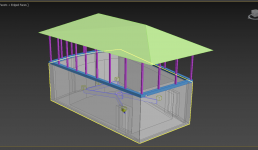 View1.png19.5 KB · Views: 68
View1.png19.5 KB · Views: 68 -
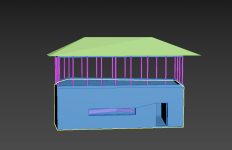 Screenshot_7.png8.9 KB · Views: 59
Screenshot_7.png8.9 KB · Views: 59 -
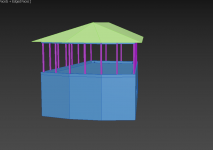 Screenshot_6.png8.5 KB · Views: 67
Screenshot_6.png8.5 KB · Views: 67 -
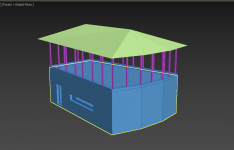 Screenshot_5.png11.4 KB · Views: 56
Screenshot_5.png11.4 KB · Views: 56 -
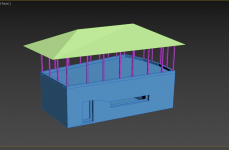 Screenshot_4.png10.3 KB · Views: 58
Screenshot_4.png10.3 KB · Views: 58 -
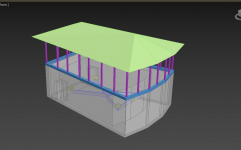 Screenshot_3.png17 KB · Views: 56
Screenshot_3.png17 KB · Views: 56 -
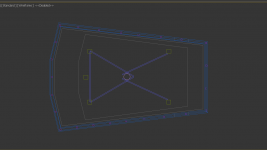 Screenshot_2.png8.3 KB · Views: 65
Screenshot_2.png8.3 KB · Views: 65 -
 Screenshot_1.png7.8 KB · Views: 66
Screenshot_1.png7.8 KB · Views: 66 -
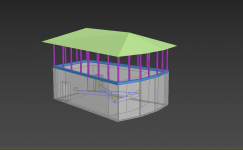 View5.png9.8 KB · Views: 68
View5.png9.8 KB · Views: 68 -
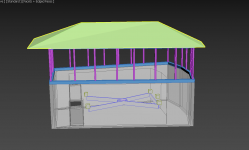 View4.png14 KB · Views: 60
View4.png14 KB · Views: 60 -
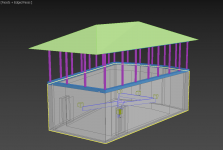 VIew3.png15.5 KB · Views: 61
VIew3.png15.5 KB · Views: 61 -
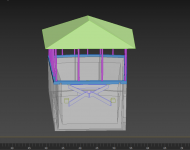 View2.png10.1 KB · Views: 60
View2.png10.1 KB · Views: 60
..looks like a multi-channel setup.
This brings up the question: is this going to be primarily for multi-channel work?
The non-parallel walls and the front (along with the other sides) acoustic bass trap is interesting.😎 Note however that unless there is sufficient and properly spaced rockwool/mineral wool absorbers (that's air-space between the absorbers) - that lower density fiber works better to absorb low freq.s as thickness increases. Ironically here cheaper fiberglass batting rolls do a better job than rockwool. Just a foot in thickness with about 25lb material can do a better job than higher weight material like rockwool (which is often nearing 65lb); as you go thicker in material its weight should also go down some to achieve the best result.
As Storm Mastering is commenting on (Reverberation Time): as a guess it looks well designed for low freq. decay and reduced mode activity (and that is something that needs to be modeled).
https://www.afmg.eu/en/ease-enhanced-acoustic-simulator-engineers
This brings up the question: is this going to be primarily for multi-channel work?
The non-parallel walls and the front (along with the other sides) acoustic bass trap is interesting.😎 Note however that unless there is sufficient and properly spaced rockwool/mineral wool absorbers (that's air-space between the absorbers) - that lower density fiber works better to absorb low freq.s as thickness increases. Ironically here cheaper fiberglass batting rolls do a better job than rockwool. Just a foot in thickness with about 25lb material can do a better job than higher weight material like rockwool (which is often nearing 65lb); as you go thicker in material its weight should also go down some to achieve the best result.
As Storm Mastering is commenting on (Reverberation Time): as a guess it looks well designed for low freq. decay and reduced mode activity (and that is something that needs to be modeled).
https://www.afmg.eu/en/ease-enhanced-acoustic-simulator-engineers
Last edited:
Well, to add to the list a worthwhile name needing to be mentioned - Bernie Grundman uses some old Tannoys with the 3838 drivers and custom Mastering Labs crossovers. I would trust this man to know his stuff based on his 5+ decade career having mastered thousands of popular albums we all know and own. He's been at this since he started in 1966. He has a really good ear and knows what flat sounds like, even in his older years. I've been to his studio in Hollywood and can say without doubt he still hears very well. He has a very refined yet simple setup for monitoring and its definitely reference quality.
www.berniegrundmanmastering.com/equipment-technology.html
For mid field monitoring I personally like the ATC SCM50s and the older PMC IB1, both of which I've owned. To me the lower to upper mids are the most important part of a good monitor. Phase tracking has to be good from 500 - 10k with good sense of speed, transient response and low power compression. I've listened to a few of the older Tannoy SRM15 coax setups which can sound extremely good if done right with good crossovers.
www.berniegrundmanmastering.com/equipment-technology.html
For mid field monitoring I personally like the ATC SCM50s and the older PMC IB1, both of which I've owned. To me the lower to upper mids are the most important part of a good monitor. Phase tracking has to be good from 500 - 10k with good sense of speed, transient response and low power compression. I've listened to a few of the older Tannoy SRM15 coax setups which can sound extremely good if done right with good crossovers.
We’re on to a VERY different thing now with spacial Audio......and apple to oranges discussion. We could go on and on here for days but in the end, the epic titles known and most often referenced by music lovers well ALL mastered in free space and there’s a reason those titles move us.Well if you are entitled to your opinion, but, I and lots of studios disagree ...and https://www.genelec.com/-/reference...owerful-genelec-dolby-atmos-system-in-the-u.s. and https://www.thisismetropolis.com/atmos-mastering/#gallery-4 and https://www.solidstatelogic.com/med...olid-state-logic-system-t-s500-mixing-console (using ATC monitors recessed and on wall) and https://splicepost.com/what-we-do#sound ... Lots more but you get the point!
I think I’ve made my point here and there’s little more to be argued....if the GOAL is a production mastering scenario to get the work done quickly and with the clients approval......have at it....do WHATEVER butters your bread. In the realm of today’s churn of heaps of mediocrity, very few will ever notice that it’s all shrink wrapped minutiae. The OP came here with a passion possibly, to design, build and create something special so harken the golden years and the systems those mastering engineers used
Check out Barry Diament’s mastering suite.......Maggie’s in free space....the guy Yes, LED Zep and Bad Co chose to remaster their timeless classics.....or go listen to the remastered Close to The Edge album often regarded in the industry and amongst audiophiles as the gold standard of mastering.....if the goal is to create some really fine art.....this is where you wanna be.
Check out Barry Diament’s mastering suite.......Maggie’s in free space....the guy Yes, LED Zep and Bad Co chose to remaster their timeless classics.....or go listen to the remastered Close to The Edge album often regarded in the industry and amongst audiophiles as the gold standard of mastering.....if the goal is to create some really fine art.....this is where you wanna be.
Based on what you've wrote about the general characteristics and the driver types you've mentioned, I think I see a couple of design constraints.
- If you want a ribbon tweeter, I think that calls for a HF crossover around 3kHz. Of course it's also makes sense having a mid dome to use it up to around that frequency.
Based on the rule of thumb that for a LR4 MF-HF crossover, a 1-1.2x wavelength vertical spacing works well, you could aim for this, so this detail of the MF-HF is then determined.
- Looking at the off-axis measurements of the Viawave SRT-7 ribbon tweeter on HifiCompass, at 3kHz, 45deg: -2dB, 60deg -3dB.
Looking at measurements of the BlieSMa M74A mid dome on HifiCompass (personally, I think the hard diaphragm is cool), at 3kHz, 45deg: -3dB, 60deg -5dB.
Looking at measurements of the Volt VM752 on AudioXpress, at 3kHz, 45deg: -9dB.
So I think as far as off-axis matching, the BlieSMa mid dome is a better match. (But I wonder what I'm missing.)
- It sounds to me right now the speaker shall be fairly compact overall, maybe narrow is preferred, one reason for the side firing woofers.
In any case if you want to keep it compact as possible but have two 15s, these 15s have to be more of a subwoofer type drivers with low Vas, Qts, Fs, to be able to squeeze not one but two of them into relatively small volume. One of the best candidates I can think of is the Beyma 15QLEX1600Fe, quick sim shows two of them could be squeezed into a 40l box with Qtc around 0.5. Fb around 90Hz, so a pretty huge is going to be needed, in Xmax couldn't be reached by using two of the 250W channels of say the Hypex FA253 plate amp. Or one could do around 3db more SPL for the same power in a 80l box with the B&C 15TBX100 for example, but overall the same idea.
- Considering this, it's one more reason to make it a 4-way. Say with one of the 3-channel Hypex plate amps, you'd use 2 amp channels for this sub portion, and the 100W tweeter channel for the 3-way top that has an all passive crossover. Certainly, with these drivers it'd be possible to achieve very linear FR with a passive crossover, then you'd apply a HPF to cross to the sub portion and a final FIR to micromanage the FR, linearize the phase. (Not that complicated, I guess, actually, it would be even possible implement the Linkwitz transform, LPF for the sub and the HPF for the top with an active line level filter box, if one one doesn't want to use a DSP plate amp but his own DAC, and then do the FIR upstream.)
- The BlieSMa M74 is said to perform nicely when crossed at 600Hz (just going by what I've read here), the datasheet says the recommended range is 400Hz and up. Crossing it around 500-600Hz to a 8" mid-woofer would be close to within 1/4 wavelength. The B&C 8NDL51 is a pretty cool 8" mid-woofer. Again, based on a quick sim, in just 9l volume it would give Fb = 110Hz, Qtc = 0.57, would cross around there to the sub with a 2nd order HPF. The sensitivity is 94dB, definitely useful for implementing the top as all passive.
- Maybe it could be separate "modules". 9l for the mid-woofer box is not too big, another box would contain the MF and HF, and sub below.
- If you want a ribbon tweeter, I think that calls for a HF crossover around 3kHz. Of course it's also makes sense having a mid dome to use it up to around that frequency.
Based on the rule of thumb that for a LR4 MF-HF crossover, a 1-1.2x wavelength vertical spacing works well, you could aim for this, so this detail of the MF-HF is then determined.
- Looking at the off-axis measurements of the Viawave SRT-7 ribbon tweeter on HifiCompass, at 3kHz, 45deg: -2dB, 60deg -3dB.
Looking at measurements of the BlieSMa M74A mid dome on HifiCompass (personally, I think the hard diaphragm is cool), at 3kHz, 45deg: -3dB, 60deg -5dB.
Looking at measurements of the Volt VM752 on AudioXpress, at 3kHz, 45deg: -9dB.
So I think as far as off-axis matching, the BlieSMa mid dome is a better match. (But I wonder what I'm missing.)
- It sounds to me right now the speaker shall be fairly compact overall, maybe narrow is preferred, one reason for the side firing woofers.
In any case if you want to keep it compact as possible but have two 15s, these 15s have to be more of a subwoofer type drivers with low Vas, Qts, Fs, to be able to squeeze not one but two of them into relatively small volume. One of the best candidates I can think of is the Beyma 15QLEX1600Fe, quick sim shows two of them could be squeezed into a 40l box with Qtc around 0.5. Fb around 90Hz, so a pretty huge is going to be needed, in Xmax couldn't be reached by using two of the 250W channels of say the Hypex FA253 plate amp. Or one could do around 3db more SPL for the same power in a 80l box with the B&C 15TBX100 for example, but overall the same idea.
- Considering this, it's one more reason to make it a 4-way. Say with one of the 3-channel Hypex plate amps, you'd use 2 amp channels for this sub portion, and the 100W tweeter channel for the 3-way top that has an all passive crossover. Certainly, with these drivers it'd be possible to achieve very linear FR with a passive crossover, then you'd apply a HPF to cross to the sub portion and a final FIR to micromanage the FR, linearize the phase. (Not that complicated, I guess, actually, it would be even possible implement the Linkwitz transform, LPF for the sub and the HPF for the top with an active line level filter box, if one one doesn't want to use a DSP plate amp but his own DAC, and then do the FIR upstream.)
- The BlieSMa M74 is said to perform nicely when crossed at 600Hz (just going by what I've read here), the datasheet says the recommended range is 400Hz and up. Crossing it around 500-600Hz to a 8" mid-woofer would be close to within 1/4 wavelength. The B&C 8NDL51 is a pretty cool 8" mid-woofer. Again, based on a quick sim, in just 9l volume it would give Fb = 110Hz, Qtc = 0.57, would cross around there to the sub with a 2nd order HPF. The sensitivity is 94dB, definitely useful for implementing the top as all passive.
- Maybe it could be separate "modules". 9l for the mid-woofer box is not too big, another box would contain the MF and HF, and sub below.
Anybody any thoughts regarding the spectral decay plot of that Bliesma dome? A lot of metal 4” and 5” cones do better…
I'm not that impressed by the new large bliesma domes. The tweeters I like though. The T34B and T25B are well engineered drivers. If I were to choose a good cone mid that could hang with a large woofer, it would be the PRV 6MR500-NDY with its honest presentation and open midrange. Its very efficient with 95 dB/W rising response which is great for use in a WG as well.
If it was a lower efficiency deal your going for, I'd choose either the Peerless NE180W for crossing around 2.5k to a larger HF dome or NE149W crossing to a smaller HF dome at about 3.5k. I regard both of those as the poor man's SS Revelator and very close in sound without the price. If you need a higher crossover, you're probably needing to build a 3 way with smaller LF drivers and higher mid HP.
I'm a big fan of mid domes and the 3 I like most are the Morel MDM55 (CAM558), Scan Speak D7608-9200 (D75MX41) and Visaton DSM50FFL.
The MDM55 is the easiest to integrate and works with a 4 k+ tweeter HP, but requires a min 800 hz 2nd order HP if you're going to play it louder. It does very well with dynamics and stays composed at higher drive levels if the xover is done right thanks to a 1mm xmax. I recommend running either the MDT30 or CAT378 tweeter with it.
The Visaton DSM50 is a detailed sounding Ti mid dome that works well together with a smaller hard dome tweeter, but it also needs a 800 to 1000 hz 2nd order HP to avoid excess THD from a small xmax, especially when pushed harder. I'd use a good 25mm metal dome with it ie. Audax TW025A28 gold dome (my favorite Ti dome) or any other decent Seas, Scan Speak metal dome.
The SS D7608 is a rare breed of driver. It sounds very detailed, open and honest with the right combination of supporting drivers. It needs special attention to get the best from it and won't go lowee than 800 hz 2nd order if you're going to want realistic levels from it. The rear chamber needs to be configured so that Qtc is lowered to less than 0.9 with the help of heavy dampening. The LP has to be at least 900 hz 2nd order if its going to play louder. Its weakness is the low xmax, limiting the HP frequency, so its definitely a candidate for a 4 way setup and most people will choose a cone mid instead due to these limitations. Given the chance to prove itself under the right circumstances, it will reward with very open, analytical sound that most cone mids can't achieve. You can't (shouldn't) cross it higher than 3 k if you want decent off axis performance to cross with a larger dome. I like running a larger HF dome with it ie Audax TW034, Seas T35-C002 or Peerless DA32TX00 corundum dome.
One thing I'm not fond of is AMT HF drivers. They sound harsh to my ears crossed lower. I dont know why, but I'm sure it has to do with resonances within the driver element material. I prefer a good planar or ribbon over an AMT if a higher xover is possible. The only exception are a few Mundorf AMTs.
Another larger cone mid to consider is the B&C 8PE21. Its very flat and clean up to 3.5 k and 97 dB sensitivity. It can cross anywhere over 300 hz 2nd order (lower with a WG + top end is limited to 1k). The 8PS21 is better down lower as a midbass and works well up to 1 - 1.5k 92 dB sensitivity. The 8NDL51 is my favorite pro sound mid bass. It plays super clean with some of the lowest THD I've seen from an 8" midbass. It does well in small sealed box (10 - 15 liters) to bridge the gap between a large LF driver and your favorite larger 1" CD / WG combo. The Eminence Beta 8A is also worth mentioning and does well as a mid from 200 hz (xmax limited) to 3.5k at 94 - 95 dB/W with a similar formulation cone as the 8PE21, giving it very smooth FR. Its very durable as a mid in a larger system or in a small 2 way.
If it was a lower efficiency deal your going for, I'd choose either the Peerless NE180W for crossing around 2.5k to a larger HF dome or NE149W crossing to a smaller HF dome at about 3.5k. I regard both of those as the poor man's SS Revelator and very close in sound without the price. If you need a higher crossover, you're probably needing to build a 3 way with smaller LF drivers and higher mid HP.
I'm a big fan of mid domes and the 3 I like most are the Morel MDM55 (CAM558), Scan Speak D7608-9200 (D75MX41) and Visaton DSM50FFL.
The MDM55 is the easiest to integrate and works with a 4 k+ tweeter HP, but requires a min 800 hz 2nd order HP if you're going to play it louder. It does very well with dynamics and stays composed at higher drive levels if the xover is done right thanks to a 1mm xmax. I recommend running either the MDT30 or CAT378 tweeter with it.
The Visaton DSM50 is a detailed sounding Ti mid dome that works well together with a smaller hard dome tweeter, but it also needs a 800 to 1000 hz 2nd order HP to avoid excess THD from a small xmax, especially when pushed harder. I'd use a good 25mm metal dome with it ie. Audax TW025A28 gold dome (my favorite Ti dome) or any other decent Seas, Scan Speak metal dome.
The SS D7608 is a rare breed of driver. It sounds very detailed, open and honest with the right combination of supporting drivers. It needs special attention to get the best from it and won't go lowee than 800 hz 2nd order if you're going to want realistic levels from it. The rear chamber needs to be configured so that Qtc is lowered to less than 0.9 with the help of heavy dampening. The LP has to be at least 900 hz 2nd order if its going to play louder. Its weakness is the low xmax, limiting the HP frequency, so its definitely a candidate for a 4 way setup and most people will choose a cone mid instead due to these limitations. Given the chance to prove itself under the right circumstances, it will reward with very open, analytical sound that most cone mids can't achieve. You can't (shouldn't) cross it higher than 3 k if you want decent off axis performance to cross with a larger dome. I like running a larger HF dome with it ie Audax TW034, Seas T35-C002 or Peerless DA32TX00 corundum dome.
One thing I'm not fond of is AMT HF drivers. They sound harsh to my ears crossed lower. I dont know why, but I'm sure it has to do with resonances within the driver element material. I prefer a good planar or ribbon over an AMT if a higher xover is possible. The only exception are a few Mundorf AMTs.
Another larger cone mid to consider is the B&C 8PE21. Its very flat and clean up to 3.5 k and 97 dB sensitivity. It can cross anywhere over 300 hz 2nd order (lower with a WG + top end is limited to 1k). The 8PS21 is better down lower as a midbass and works well up to 1 - 1.5k 92 dB sensitivity. The 8NDL51 is my favorite pro sound mid bass. It plays super clean with some of the lowest THD I've seen from an 8" midbass. It does well in small sealed box (10 - 15 liters) to bridge the gap between a large LF driver and your favorite larger 1" CD / WG combo. The Eminence Beta 8A is also worth mentioning and does well as a mid from 200 hz (xmax limited) to 3.5k at 94 - 95 dB/W with a similar formulation cone as the 8PE21, giving it very smooth FR. Its very durable as a mid in a larger system or in a small 2 way.
Have you used/heard them already, @profiguy ?I'm not that impressed by the new large bliesma domes.
Later I realized that I was looking at the vertical measurements. So scratch that, the primary interest is the horizontals. Horizontally it's wider than those numbers, -1dB at best.- Looking at the off-axis measurements of the Viawave SRT-7 ribbon tweeter on HifiCompass, at 3kHz, 45deg: -2dB, 60deg -3dB.
By the way the Genelec S30D has sort of constant directivity HF (measurements in the manual), so probably the Viawave SRT-7 with more rolled-off off-axis HF wouldn't be the same sound.
But the Viawave GRT-145W with the small waveguide could be considered close (measurements on Troels Gravesen's website), and the off-axis looks more orderly, and narrower off-axis at 3kHz is also provided to match the mid better.
HifiCompass has a CSD plot. The FR is very linear and smooth in its indented range, I couldn't find a cone right now that has better looking FR or CSD. You'd use this driver in conjunction with passive components implementing a notch for the breakup, similarly to how it's done in the recent application note by Purifi for their alu cone woofer. Otherwise great specs and measurements, I see no controversies. High B, titanium voice coil former, I imagine it's no slouch, I don't think you can find a 4" cone with similar efficiency.Anybody any thoughts regarding the spectral decay plot of that Bliesma dome? A lot of metal 4” and 5” cones do better…
Ive heard the alu (looked like prototype) version in an active 3 way system. They sounded strained to my ears. Could be different in current production drivers. I verified the dsp settings, which were reasonable for a larger dome. HP was set around 500 LR4, 4k LR2 LP. There was a weird kind of fizzy distortion that sounded like the type of distortion you get with a not so great diffraction WG pushed too low. Everything sounded better just swapping in a volt 3" dome without any adjustments.
This is a great 5 inch Pro midrange https://www.bmsspeakers.com/index.php-19.html?id=bms_5n160 note the distortion measurement are taken at 100 watts (!) and raised 10dB on the graph. Also Mms only 8.3g with a Bl of 11.3... Thats a superb "fast" driver, which sounds incredibly detailed and accurate.I don't think you can find a 4" cone with similar efficiency.
Last edited:
- Home
- Loudspeakers
- Multi-Way
- Ultimate Mastering Monitor Speakers